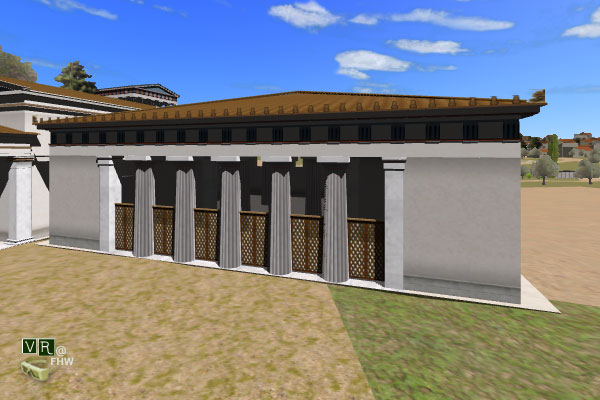Location: West Street, next to the Tholos. No 4 in the Agora plan of the Guide: Μc Camp II, J., The Athenian Agora, A Short Guide to the Excavations, Excavations of the Athenian Agora, Picture Book no 16, American School of Classical Studies (Princeton 2003), p. 2 and pp. 24-25, no. 8.
Date of construction: Late 6th cent. BC / early 5th cent. BC.
Periods of Use: Classical (it acquires a different function after 410 BC: Metroon)
INTRODUCTION
Τhe Old Bouleuterion has been identified thanks to an inscription discovered in situ. In terms of architecture this is an unexceptional building; this structure, however, housed the first democratically elected boule (Council) of ancient Athens. It was later replaced by the so-called New Bouleuterion. After c.410 BC it housed the public records and the worship of the Mother of Gods. It was finally demolished in 150 BC, and the Hellenistic Metroon was erected in its place.
CLASSICAL PERIOD
History of the excavations
It was surveyed by the German Archaeological Institute in 1895-1896 and by the Athenian Archaeological Society in 1907-1908, but it was not properly identified. It was excavated in 1934-1935 by the American School of Classical Studies.
Almost nothing remains of its superstructure. Part of the foundations of the walls and the floor survive, and this has made its representation possible.
Building’s plan
The foundations in the exterior of the building reveal an almost square structure, measuring 23.30m (E-W) × 23.80m (N-S). Its dimension at the toichobate are 22.74 × 23.30m. The foundation coursing the interior of the building at its northeast axis indicates the existence of a wide room around the walls of which wooden benches were arranged in a Pi-shape, as well as of an orthogonal anteroom. There were 5 columns in its interior, also arranged in a Pi-shape, resting on stone bases.
The directors of the excavations in the Agora recently commissioned a three-dimensional model of the building, featuring a colonnade of 5 Doric columns in the façade and intercolumnal spaces barred with wooden parapets. Evidently, this is a speculative representation.
Traces of compacted earth have been discovered in the interior of the building, on which the non-extant slabbed floor rested. Internally, the level of the floor was higher than that of the outer surrounding area, standing taller than the first layer of yellow soft poros blocks used for the superstructure.
The excavators posited the existence of two entrances in the south side of the building. Along its southern side there was a small stairway of two steps.
The building’s uses
The discovery of an Archaic marble louterion bearing the inscription “ΒΟΛΕΥΤΗΡΙΟ” (Bouleuterion) very close to the building has allowed the identification of this space with the city’s first council house; it was probably erected specifically with the purpose of housing the Boule of the 500, which was founded after Cleisthenes' reforms of 508/507 BC. It continued to fulfil this function until the late 5th cent. BC, when the New Bouleuterion was erected (possibly following the incidents of 413/412 BC). Since then it was used as a place for storing the city’s archives and harboured the worship of the Mother of the Gods, until c.150 BC, when it was replaced by the Hellenistic Metroon.
BIBLIOGRAPHY
Αρχαία Αγορά της Αθήνας – Άρειος Πάγος. Σύντομο Ιστορικό και Περιήγηση, Έκδοση της Ένωσης Φίλων Ακροπόλεως (Αθήνα 2004), p. 11.
BOERSMA, J.S., Athenian Building Policy from 561/560 to 405/404 B.C. (Scripta Archaeologica Groningana 4, Groningen 1970), p. 204, no. 76.
Mc CAMP II, J., The Athenian Agora: A Guide to the Excavation and Museum4 (Αθήνα 1990).
Μc CAMP II, J., The Athenian Agora, A Short Guide to the Excavations, Excavations of the Athenian Agora, Picture Book no 16, American School of Classical Studies (Princeton 2003), pp. 14-15.
Mc CAMP II, J., Η Αρχαία Αγορά της Αθήνας. Οι ανασκαφές στην καρδιά της κλασικής πόλης2 (Aθήνα 2004), pp. 73-76.
MARTIN, R., Recherches sur l’Agora grecque (Paris 1951), σελ. 266-267.
THOMPSON, H.A., ‘Buildings on the West Side of the Athenian Agora’, Hesperia 6 (1937), pp. 1-222 (esp. pp. 127-135).
THOMPSON, H.A. – WYCHERLEY, R., The Agora of Athens. The American Excavations in the Athenian Agora, vol. XIV, American School of Classical Studies at Athens (Princeton 1972), pp. 29-36.
TRAVLOS, J., Pictorial Dictionary of Ancient Athens (Princeton 1971).

Old Bouleuterion, Representation in VR environment 
